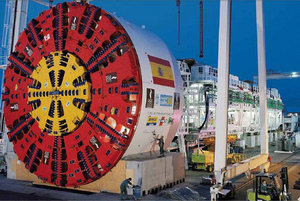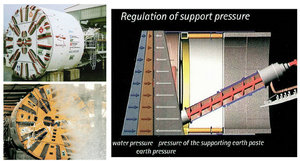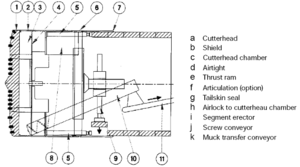

Definition
EPBS or earth-pressure balance shields are TBMs used for the excavation of soils where face support and counter-effect of ground water pressure is obtained by means of the material excavated by the cutting wheel, which serves as support medium itself.
Principle

The cutterhead serves as the means of excavation whereas face support is provided by the excavated earth which is kept under pressure inside the excavation chamber by the thrust jacks on the shield.
These jacks transfer the pressure to the separation bulkhead between the shield and the excavation chamber, and hence to the excavated earth.
Excavated debris is removed from the excavation chamber by a screw conveyor which allows the gradual reduction of pressure.
Main components
The main components of the machine are:

- Cutterhead: Which rotates with cutting spokes
- Protective Shield similar to that used for closed slurry shields
- Screw conveyor, which evacuates the earth from the pressurized chamber gradually as the excavation takes place, enabling the control of the pressure within the chamber.
- Thrust System: Longitudinal jacks which brace against the lining of precast segments
Main field of application
These machines are used to excavate grounds with limited or no self-supporting capacity. In granulometric terms, earth pressure balance shields are mainly used for excavating in silts or clays with sand.
The use of additives, such as high-density mud of foams, enables excavation in sandy-gravely soil too, if needed.
EPBMs can also operate in open or with compressed air confinement if specially equipped.
(Text and diagram source: Recommendations and guidelines for tunnel boring machines – Working group 14 ITA)
